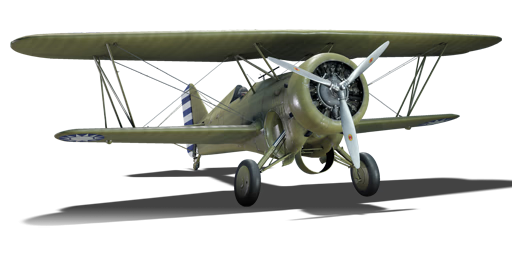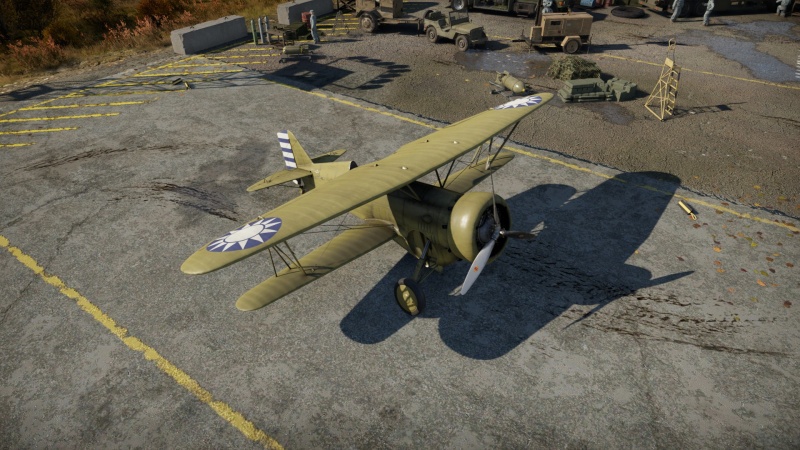Hawk III
Contents
Description
The Hawk III is a premium rank I Chinese fighter with a battle rating of 1.0 (AB/RB) and 1.3 (SB). It was introduced in Update 1.91 "Night Vision". Players should note that the Hawk III's landing gear takes an extremely long time to retract and lower, so when landing, you should lower the landing gear well before you think you should.
General info
Flight performance
| Characteristics | Max Speed (km/h at 4,850 m) |
Max altitude (metres) |
Turn time (seconds) |
Rate of climb (metres/second) |
Take-off run (metres) | |||
|---|---|---|---|---|---|---|---|---|
| AB | RB | AB | RB | AB | RB | |||
| Stock | 425 | 414 | 10700 | 13.9 | 14.4 | 12.0 | 12.0 | 274 |
| Upgraded | 466 | 444 | 13.0 | 13.3 | 19.3 | 15.2 | ||
Details
| Features | ||||
|---|---|---|---|---|
| Combat flaps | Take-off flaps | Landing flaps | Air brakes | Arrestor gear |
| X | X | X | X | ✓ |
| Limits | ||||||
|---|---|---|---|---|---|---|
| Wings (km/h) | Gear (km/h) | Flaps (km/h) | Max Static G | |||
| Combat | Take-off | Landing | + | - | ||
| 600 | 280 | N/A | N/A | N/A | ~12 | ~6 |
| Optimal velocities (km/h) | |||
|---|---|---|---|
| Ailerons | Rudder | Elevators | Radiator |
| < 240 | < 220 | < 400 | > 250 |
| Compressor (RB/SB) | ||
|---|---|---|
| Setting 1 | ||
| Optimal altitude | 100% Engine power | WEP Engine power |
| 2,926 m | 745 hp | 856 hp |
Survivability and armour
The Hawk III does not have any armour, and the pilot is exposed. There is one large fuel tank located in front of the pilot.
Modifications and economy
Armaments
Offensive armament
The Hawk III is armed with:
- 2 x 7.62 mm Browning machine guns, nose-mounted (600 rpg = 1,200 total)
The Browning machine guns aren't particularly powerful, even for the low battle rating. The small calibre of the machine guns (one of the smallest in the game) coupled to their low number (only 2) leads to a very poor one-second burst mass. To deal damage effectively, one must learn to lead accurately and track consistently, landing as many bullets on target for as long as possible. Avoid firing a volley of bullets in the target's flight path with minimal lead adjustments and waiting for the target to crash into your line of fire, since this means that the target will get only a few hits. This tactic is more for heavy-punching aircraft like late-war interceptors, while planes with small one-second burst mass like the Hawk III will struggle to kill. Also note that the projectiles have a large circular spread, even with the New machineguns modification installed. Therefore when shooting from ~500 m away, expect a significant drop in hits. Nevertheless, with precise aiming, the MGs are still adequate for destroying the wooden biplanes that the Hawk III encounters. Against aircraft, the universal belt is most effective.
Suspended armament
The Hawk III can be outfitted with the following ordnance:
- Without load
- 4 x 100 lb AN-M30A1 bombs (400 lb total)
- 1 x 500 lb AN-M64A1 bomb + 4 x 100 lb AN-M30A1 bombs (900 lb total)
The Hawk III is very unique for a biplane fighter, as it has the ability to carry almost 1,000 lbs of bombs. Note that the 100 lb bombs will drop in 2 pairs, followed by the single 500 lb one. However, note that the full bomb load will impede flight performance quite significantly. Also, it is safer to set a bomb fuse of at least 2 seconds, since the Hawk III is a slow biplane, so dropping the 500 lb bomb when close to the ground will result in the player not being able to zoom out of the blast radius in time and getting destroyed by its own bomb.
Usage in battles
The Hawk III is a very unique, fun aircraft to fly and has a couple of very interesting perks. It is very competitive as a biplane fighter, and also has the ability to carry a very substantial bombload. Sometimes one may wish to land quicker to join back the fight, so it is a good idea to belly-land the aircraft without waiting for the landing gears to completely extend since it takes a whopping ~50 seconds to do so. Cut throttle to slow down to ~190 km/h as you are about to land. Continue to decelerate and avoid landing too fast (at most ~170 km/h), as the Hawk III tend to tilt forward or even flip upside down under its momentum.
Air battles:
In air battles, the plane can be approached in several different ways. The first, and simplest, way is to play the Hawk III as a fighter. Indeed, the aircraft is highly manoeuvrable (can turn competitively with most aircraft except the I-15) and has a good top speed as well. In this style, take off, and climb altitude a bit, and then engage any targets available. However, do not fly too aggressively as the aircraft can get itself into sticky situations where it is being pursued by multiple enemy aircraft. Make sure to fly with teammates, and work together to avoid a quick death. The 7.7 mm Browning guns are rather weak, but more than enough to destroy the fabric and wood aircraft that the Hawk III faces normally. Finally, note that the aircraft's landing gear is manually cranked, and takes up to ~30 seconds to retract/deploy. Keep this in mind, and always deploy landing gear early when preparing to land.
The second, and more interesting, playstyle of the Hawk III is to fly it as a ground attacker. This is particularly interesting because the Hawk the can carry a large bomb load of 900 lbs, split between four 100 lb bombs and one 500 lb bomb. If flying this way, try to avoid engaging in fighter combat, as the bombs will decrease the Hawk's flight performance significantly. As well, the bombs are all of a lower size, meaning that they are best suited for destroying softer targets such as armoured cars and AAA batteries. Finally, note that the 100 lb bombs drop in pairs. This means that, instead of hitting five targets, you will only be able to hit three targets. Once you have dropped your bombs, return to the normal duties of a fighter aircraft - that is where the Hawk III excels.
Ground battles:
As with the aforementioned ground attack playstyle, the Hawk III is a great complementary aircraft for lower-tier Chinese lineups. The aircraft's great manoeuvrability and good suspended ordnance means that it can be used as a potent early ground attacker. The relatively large bomb load should be used against more clustered targets, to maximize the amount of targets hit in a single strike. After bombing, you have two options - either return to base to rearm, or serve as a fighter aircraft. The former strategy is better if you prefer to hit ground targets rather than fight other aircraft, while the latter strategy works better when there are enemy aircraft (especially bombers or attacker) in the area. Of course, either strategy can work so it depends on player preference.
Manual Engine Control
| MEC elements | ||||||
|---|---|---|---|---|---|---|
| Mixer | Pitch | Radiator | Supercharger | Turbocharger | ||
| Oil | Water | Type | ||||
| Controllable | Controllable Not auto controlled |
Not controllable Not auto controlled |
Not controllable Not auto controlled |
Separate | Not controllable 1 gear |
Not controllable |
Pros and cons
Pros:
- Large payload, good for destroying bases and ground targets in tank RB
- Good manoeuvrability and speed when unladen
- Has good low speed handling and low stall speed
- Retractable gears reduce drag
Cons:
- Armament is rather light and inflicts weak damage
- Slightly lower payload weight than the equally ranked Hs 123 A-1
- Painfully long gear retraction and lowering time (51 seconds for lowering and retracting)
History
The Hawk III, a modification of the US Navy BF2C-1 by Curtiss Aeroplane and Motor Company, addressed issues that was experienced during the latter's service. With a new Wright R-1820-F53 engine Cyclone engine and wooden wings (to fix a vibration issue with the metal wings of the BF2C-1), the Hawk III managed to be more flyable than its preceding design.
With the US Navy's soured experience with the BF2C-1, the Hawk III saw more sales in the export model. Argentina, Thailand, and China bought Hawk IIIs in the late 1930s. China alone bought 102 Hawk III planes from the United States between March 1936 to June 1938.
In the Sino-Japanese War, the Hawk III planes acted as the Chinese front-line fighters against Japanese aircraft. While able to stand against Japanese biplane models, the appearance of monoplanes like the A5M shifted the balance towards the Japanese. As such, the Hawk III was slowly replaced by Soviet I-15 and I-16 fighter planes.
The last surviving Hawk III aircraft resides in Thailand at the Royal Thai Air Force Museum.
Media
- Skins
- Videos
See also
- Aircraft of comparable role, configuration and era
External links
- [Wikipedia] Curtiss BF2C Goshawk
- [airliners.net] Curtiss Hawk III - The only Hawk III fighter left in the world pictured in Thailand
- Official data sheet - more details about the performance
| Curtiss-Wright Corporation | |
|---|---|
| Fighters | BF2C-1 |
| P-36A · Rasmussen's P-36A · P-36C · P-36G | |
| P-40C · P-40E-1 · P-40F-10 | |
| Bombers | SB2C-1C · SB2C-4 |
| Floatplanes | SOC-1 |
| Experimental | XP-55 |
| Export | H-75A-1 · H-75A-4 · H-81A-2 · ▂P-40E-1 · ␗P-40E-1 · ▄P-40F-5 Lafayette · CW-21 · Hawk III |
| ▄SB2C-5 | |
| Captured | ▀Hawk H-75A-2 |
| China fighters | |
|---|---|
| British | ␗Gladiator Mk I |
| French | D.510C |
| Japanese | ␗A6M2 · ␗Ki-27 otsu · ␗Ki-43-III ko · ␗Ki-44-II hei · ␗Ki-61-I otsu · ␗Ki-84 ko |
| American | CW-21 · Hawk III · P-66 · ␗P-40E-1 · H-81A-2 · ␗P-43A-1 |
| ␗P-47D-23-RA · ␗P-47D-30 · ␗F-47N-25-RE · ␗P-51C-11-NT · ␗P-51D-20 · ␗P-51K | |
| Soviet | ␗I-15bis · ␗I-153 M-62 · ␗I-16 Chung 28 · ␗I-16 type 5 · ␗I-16 type 10 · ␗I-16 type 17 · ␗La-11 · ␗La-9 |
| China premium aircraft | |
|---|---|
| Fighters | ␗A6M2 · D.510C · ␗F-47N-25-RE · H-81A-2 · Hawk III · ␗Ki-45 hei/tei · ␗Ki-84 ko · ␗P-51C-11-NT |
| Jet fighters | Shenyang F-5 · J-7D |
| Strike aircraft | A-5C · ␗F-84G-31-RE |





